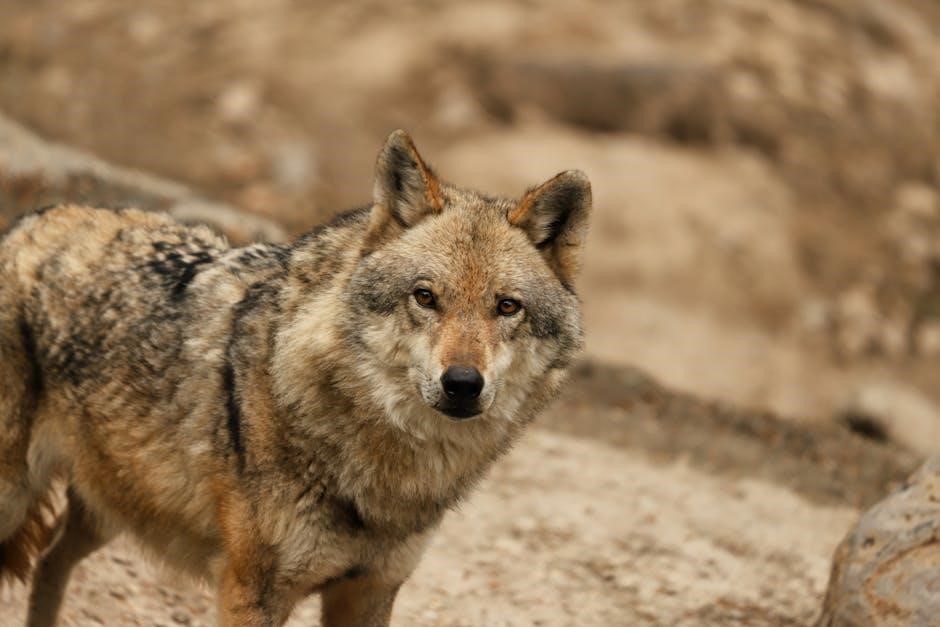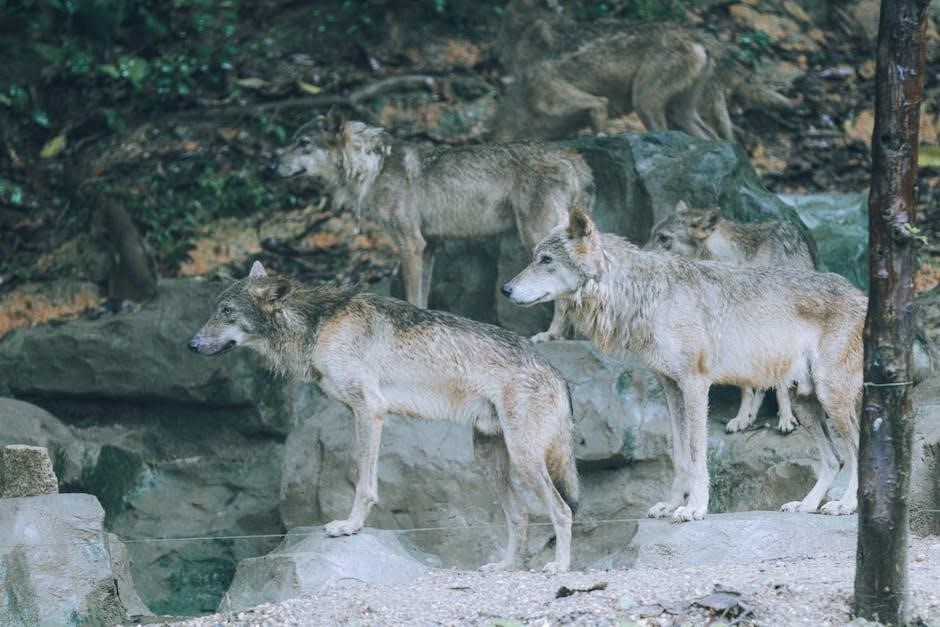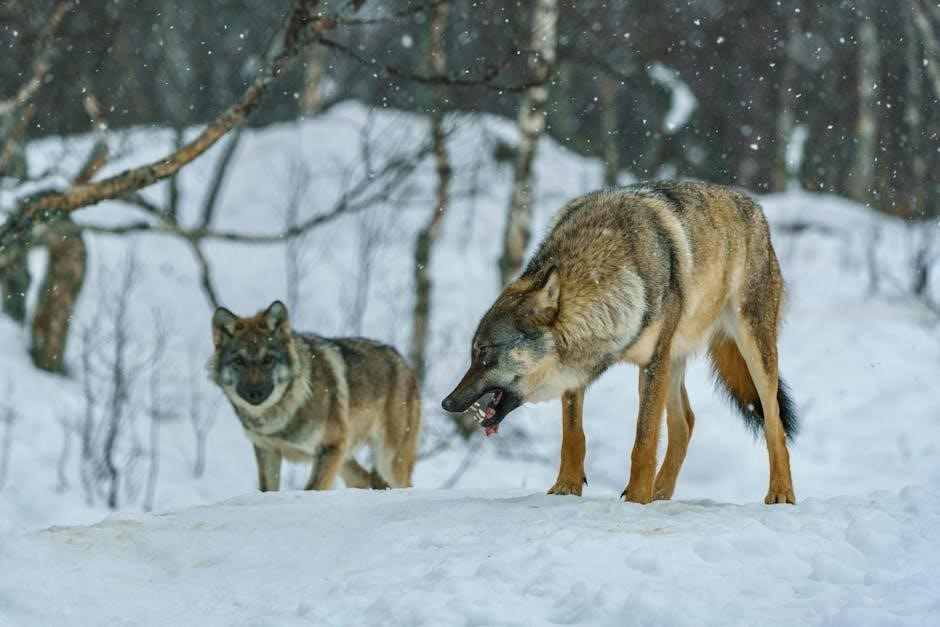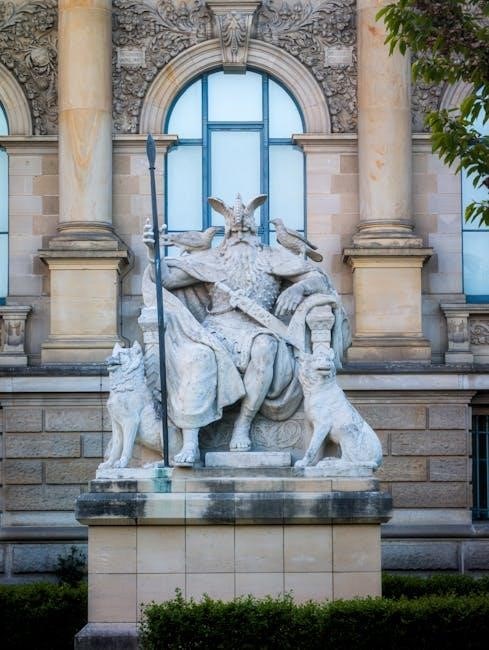
Overview of “Julie of the Wolves”
Julie of the Wolves by Jean Craighead George is a captivating novel about a young Inuk girl, Miyax Kapugen, who navigates survival in the Alaskan wilderness.
1.1 Summary of the Novel
Julie of the Wolves follows the journey of Miyax Kapugen, a 13-year-old Inuk girl, as she escapes an arranged marriage to a man named Daniel, who later attempts to harm her.
Lost in the Alaskan tundra, Miyax faces starvation, isolation, and the harsh wilderness; She learns to survive by observing and interacting with a wolf pack, led by Amaroq, forming a bond that teaches her resilience and adaptability.
The novel explores themes of survival, identity, and cultural conflict, offering a poignant exploration of the human spirit and the enduring connection between humans and nature.

1.2 Historical and Cultural Context
Julie of the Wolves is set in 20th-century Alaska, reflecting the tension between traditional Inuit life and modernization. The novel highlights the challenges faced by indigenous communities as they confront cultural changes and environmental shifts. Jean Craighead George weaves in authentic details about Inuit traditions, survival skills, and the spiritual connection with nature, offering readers a vivid portrayal of a culture navigating the pressures of a rapidly changing world. This context enriches the story’s themes of identity and resilience.
1.3 Importance of the Book in Young Adult Literature
Julie of the Wolves holds a significant place in young adult literature for its unique blend of survival, self-discovery, and cultural exploration. The novel addresses themes of identity, resilience, and the human relationship with nature, resonating deeply with adolescent readers. Its vivid storytelling and strong protagonist, Miyax, have made it a timeless classic, inspiring many other wilderness survival stories. The book’s ability to balance adventure with emotional depth has solidified its influence in the genre, making it a cherished and impactful read for young audiences.
Major Themes in “Julie of the Wolves”
Julie of the Wolves explores themes of survival, identity, and the human relationship with nature, highlighting Miyax’s journey of self-discovery and resilience in the harsh wilderness.
2.1 Survival and Adaptation
Miyax’s journey in Julie of the Wolves is a testament to the human spirit’s ability to survive and adapt in the harshest conditions. Stranded in the Alaskan wilderness, she relies on her knowledge of the land and her cultural heritage to find food, build shelter, and navigate the dangers of the tundra. Her resourcefulness and resilience are tested as she faces starvation, predators, and isolation. Through her bond with the wolf pack, she learns to adapt and thrive, symbolizing the power of observation, patience, and respect for nature.
2.2 Identity and Cultural Conflict
Miyax’s journey in Julie of the Wolves is deeply rooted in her struggle to reconcile her Inupiat heritage with the influences of modern civilization. Her father, Kapugen, embodies the traditional way of life, while her husband, Daniel, represents the encroachment of modernity; Miyax’s internal conflict intensifies as she grapples with her identity, torn between the old ways of her ancestors and the pressures of a changing world. Her time with the wolf pack becomes a metaphor for finding belonging and balance between two cultures, ultimately leading to a profound self-realization.
2.3 Human Relationship with Nature
In Julie of the Wolves, Miyax’s bond with the wolf pack and the Alaskan tundra highlights the intricate relationship between humans and nature. Her survival depends on understanding and respecting the natural world, as she learns to communicate with the wolves and adapt to the harsh environment. The novel emphasizes the interconnectedness of life, showing how nature can be both unforgiving and nurturing. Through Miyax’s journey, George illustrates the importance of living in harmony with the land and the enduring lessons it teaches about resilience and coexistence.

Key Characters and Their Roles
Miyax Kapugen, a resilient Inuk girl, navigates survival and identity. The wolf pack, led by Amaroq, becomes her protectors and surrogate family, while Daniel represents oppressive forces in her life.
3.1 Miyax Kapugen (Julie)
Miyax Kapugen, also known as Julie, is the protagonist, a 13-year-old Inuk girl struggling to balance her cultural identity with modern influences. Fleeing an abusive marriage, she finds herself lost in the Alaskan tundra, where her journey becomes one of survival and self-discovery. Through her encounters with a wolf pack, she learns resilience and reconnects with her heritage, ultimately symbolizing the clash between tradition and contemporary life. Her story is a poignant exploration of identity and the human spirit’s resilience.
3.2 The Wolf Pack and Their Significance
The wolf pack becomes Miyax’s surrogate family, teaching her survival skills and providing companionship. Led by Amaroq, the pack embodies loyalty and resilience, reflecting Miyax’s own cultural values. Their bond symbolizes belonging and adaptability, as Miyax learns to communicate and trust them. The wolves represent both nature’s ferocity and its nurturing side, mirroring Miyax’s internal struggles and growth. Their presence underscores themes of family, survival, and the interconnectedness of humans and wildlife, making them central to Miyax’s journey of self-discovery and resilience in the harsh tundra.
3.3 Kapugen and Daniel
Kapugen, Julie’s father, is a whaler whose absence leaves emotional scars, while Daniel, her abusive husband, triggers her escape. Kapugen’s cultural ties and Daniel’s betrayal symbolize Julie’s internal conflict between tradition and modernity. Their roles highlight her struggle for independence and self-discovery, shaping her journey in the tundra. Through their influence, Julie learns resilience and the importance of reconnecting with her heritage, ultimately defining her path in the wilderness and her relationship with the wolf pack.

Symbolism and Motifs
In Julie of the Wolves, the wolves symbolize family and belonging, while the tundra represents both freedom and struggle, reflecting Miyax’s internal and external journeys.
4.1 The Wolves as a Symbol of Family and Belonging
The wolves in Julie of the Wolves embody family and belonging, offering Miyax a sense of unity she lacked in her human life. Amaroq, the lead wolf, becomes a father figure, while the pack provides acceptance and loyalty. Through her bond with them, Miyax reconnects with her Eskimo heritage, finding strength and purpose. The wolves symbolize the enduring power of kinship and the deep ties that transcend species, enriching her journey of self-discovery and survival.
4.2 The Tundra as a Symbol of Freedom and Struggle
The Alaskan tundra in Julie of the Wolves symbolizes both freedom and struggle, representing Miyax’s escape from societal constraints and her battle for survival. Its vast, untouched expanse embodies liberation, offering her a chance to reconnect with her heritage. Yet, the tundra’s harshness also mirrors her internal and external challenges, testing her resilience and will to thrive. Through this duality, the tundra becomes a powerful symbol of Miyax’s journey toward self-discovery and her ultimate quest for belonging in a world shaped by nature and culture.

Writing Style and Narrative Techniques
Jean Craighead George’s vivid storytelling immerses readers in the Alaskan wilderness, using descriptive language to personify nature and create a unique bond between Miyax and the wolves.
5.1 Jean Craighead George’s Approach to Storytelling
Jean Craighead George’s storytelling in Julie of the Wolves is marked by vivid descriptions and a deep connection to nature. She immerses readers in the Alaskan wilderness through meticulous details, creating a sense of immediacy and realism. George’s prose is both poetic and accessible, allowing readers to experience Miyax’s emotional journey and survival struggles firsthand. Her ability to weave cultural insights, survival instincts, and moral lessons into the narrative makes her approach both engaging and educational, leaving a lasting impact on readers of all ages.
5.2 The Use of Nature as a Character
Nature in Julie of the Wolves is portrayed as a dynamic and integral character, shaping Miyax’s journey and identity. The Alaskan tundra, with its harsh yet majestic beauty, serves as both a antagonist and a guide, teaching her survival skills and resilience. George personifies natural elements, such as the wolves, wind, and land, creating a symbiotic relationship between Miyax and her surroundings. This anthropomorphism underscores the interconnectedness of human and natural worlds, highlighting nature’s dual role as a source of struggle and inspiration. Through this, the tundra becomes a character in its own right, influencing Miyax’s growth and decisions.
Impact and Legacy of the Novel
Julie of the Wolves has left a lasting impact on young adult literature, earning the Newbery Medal and inspiring countless wilderness survival stories with its themes of resilience and nature.
6.1 Critical Reception and Awards
Julie of the Wolves received widespread critical acclaim for its vivid storytelling and profound themes. It won the prestigious Newbery Medal in 1973, solidifying its place in children’s literature. Critics praised its authentic portrayal of survival and cultural identity, while educators lauded its educational value. The novel’s ability to weave intricate relationships between humans and nature resonated deeply with readers, making it a timeless classic. Its enduring popularity underscores its influence on modern wilderness survival narratives.
6.2 Influence on Modern Wilderness Survival Stories
Julie of the Wolves has profoundly influenced modern wilderness survival stories, setting a standard for authentic, immersive tales of resilience. Its themes of survival, identity, and nature resonate in works like Gary Paulsen’s Hatchet and Scott O’Dell’s Island of the Blue Dolphins. The novel’s detailed portrayal of living in harmony with nature and its cultural depth inspire authors to explore similar motifs, ensuring its legacy as a cornerstone of wilderness literature.
Leave a Reply
You must be logged in to post a comment.